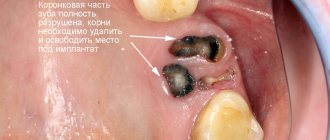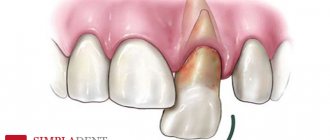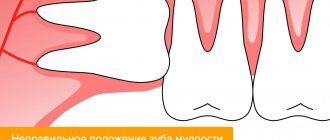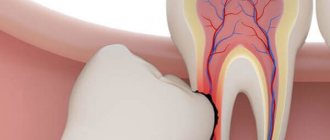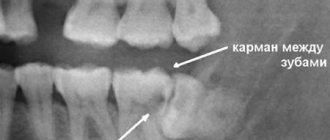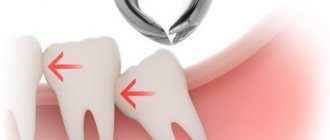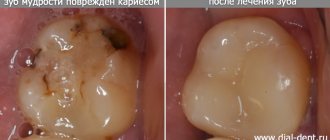Third molars do not always grow in
This is true. The formation of “eights” does not occur during uterine development, but at the age of 3-5 years. But even if their rudiments are present, eruption does not always occur. The fact is that they begin to grow at the age of 17-25 - at the age when the jaw bone has already completed its formation and the dentition is complete. And there is no room for wisdom teeth.
Often their growth is hampered by the seventh molar. The process of teething occurs individually for each person. Sometimes 1-2 units may grow, while the rest remain hidden by the gum. In some situations, none of the “eights” grows.
But there are also cases (about 8%) when people do not have the rudiments of wisdom teeth at all. In men, the upper molars often do not develop, and in women, the lower molars do not develop. That is why the norm is considered to be 28-32 teeth.
Age is not a barrier
I am 65 years old. The doctor suggests installing implants. Is this harmful at my age?
Alexey Petrovich, Balashikha
– In the middle of the last century, when dental implantation was just becoming part of widespread dental practice, contraindications to the installation of implants were quite strict. They were not installed in elderly people, patients with diabetes mellitus, or autoimmune diseases. But with the current level of medical technology, implants can be recommended to almost all patients at any age. By the way, there are no restrictions on the number of implants installed at a time. The only danger associated with this procedure is the use of general anesthesia, which can pose health risks.
However, you need to understand that the lifespan of an implant depends on your oral hygiene. If it is insufficient, it can lead to gum disease and loss of the implant.
Treat without a drill. What procedures have dentists refused? More details
"Eights" have long lost their functionality
In ancient times, people ate raw meat, roots, and they needed massive molars to chew solid food. Over time, people began to consume thermally processed, softer foods, and the urgent need for the most distant units disappeared. However, you should not completely discount them.
Despite the fact that they themselves do not take much part in chewing food, “eights” restrain the loosening of the teeth, which bear the main chewing load. And in old age they can serve as a support for a bridge.
Grow new ones
I heard that scientists will soon learn to grow new teeth to replace the ones that have fallen out. Are such developments being carried out in Russia? And when will this technology be used?
Alla, Tolyatti
– Such technologies already exist. For example, in 2006–2007, Japanese scientists managed to grow the rudiments of permanent teeth in rats. And last year, Russian scientists repeated this experiment. The material for growing teeth is stem cells, which can be taken from various tissues - adipose and others. For example, Russian scientists have patented a technology for obtaining stem cells from the tissues of human milk teeth. That is, after a baby tooth is removed, stem cells can be isolated from it, frozen, and subsequently used to grow a new tooth. The germ of such a tooth is transplanted into the socket of the extracted tooth or into the socket formed by the surgeon. This technology is currently being tested in many countries, and, according to experts, it may become widely practiced within the next 50 years.
Caries will lead to a stroke. What are the dangers of untreated teeth Read more
The eruption of “figure eights” is almost always associated with complications
Difficulties in eruption of third molars are caused not only by lack of space, but also by the fact that they do not have deciduous predecessors. Therefore, they often grow only partially or at an angle. But even the appearance of units growing correctly in most cases causes complications.
Most often found:
- destruction or displacement of adjacent teeth;
- bite problems;
- pericoronitis.
Very often, the eruption of the figure eight is accompanied by a purulent-inflammatory process. This happens because a hood appears over the tooth, and around it there is a pocket in which bacteria, plaque and food debris accumulate. They create favorable conditions for the development of inflammation (pericoronitis).
Often, when the eighth tooth appears, severe pain is felt, which occurs due to oppression of the roots of neighboring units.
About fibrin and fibrin plaque
Fibrin
- a high-molecular, non-globular protein formed from fibrinogen, synthesized in the liver, in the blood plasma under the action of the enzyme thrombin; has the form of smooth or cross-striated fibers, the clots of which form the basis of a blood clot during blood clotting. Thus, fibrin promotes rapid wound healing by forming fibrin plaque.
Fibrin plaque
- a natural phenomenon that occurs in the oral cavity in the area of surgical intervention (at the site where a tooth was removed, stitches were applied, etc.). It occurs on the 3-4th day after surgery in the oral cavity. And this is one of the normal and inevitable stages of healing of a hole covered with a blood clot. This is followed by tissue restructuring, covering the wound with protective epithelium and restoration of normal mucosa.
Patients often confuse fibrin plaque with pus, causing them to worry and call their dentists.
Why does fibrin plaque occur?
Healing of a wound in the oral cavity occurs in a moist environment. If you have a cut on your skin, once the bleeding stops, the wound will be covered with a scab. We all know from childhood that this crust cannot be torn off. A blood clot covered with fibrin plaque is essentially the same “crust”, only in the mouth. And you can't touch her either! Otherwise, the healing process will take longer and the result will be less favorable.
There is no need to rinse out fibrin plaque!
After tooth extraction, tooth transplantation or dental implantation, intensive mouth rinsing is contraindicated, otherwise you may rinse out blood clots and fibrin plaque. As a result, painful sensations will appear, and the wound healing process will be worse.
Therefore there is no need to rinse
, and especially antiseptic and refreshing rinses, which often contain alcohol. However, the mouth can be washed. Make a kind of bath to wash away food residues. For this, a solution of chamomile or even simple black tea is suitable, which you just need to take into your mouth, hold for a while on the injured area and carefully spit out.
Eighth teeth are more likely than others to suffer from caries and other diseases.
This is due to their remote location and the inability to thoroughly clean them. Which leads to a large accumulation of bacteria and the development of caries, gingivitis, and periodontitis. Treatment in such situations is possible, but filling is often complicated by twisted roots and canals. Also, many people cannot open their mouths wide enough or some have a pronounced gag reflex - this significantly complicates the dentist’s work. Due to objective reasons, the “eights” are treated poorly.
Therefore, if the patient wants to keep the unit, a consultation with a dentist is required, who can professionally assess the situation and make the right decision.
With or without fluoride?
Nowadays there is a lot of talk about the dangers of toothpastes with fluoride. Allegedly, they can harm dental health. On the other hand, it is believed that fluoride-containing pastes are the best prevention of caries. Where is the truth?
Nina, Mytishchi
– Fluoride is really necessary for dental health, because it makes the enamel more resistant to various acids, and therefore protects teeth from caries. However, its excess can lead to another dental disease - fluorosis, which, like caries, leads to the destruction of tooth enamel. Fluoride mainly enters the body through water or food. But the fluoride content in toothpastes is not too high, and the duration of exposure of the toothpaste to the enamel during brushing is completely minimal. Therefore, pastes cannot cause fluorosis, but they are also unable to effectively protect teeth from caries. Although most studies show that the use of fluoride-containing toothpastes to a certain extent reduces the incidence of caries. Therefore, whether to buy toothpaste with fluoride or not is a personal choice.
Wisdom teeth need to be removed early
There is still debate in the dental community about the need to remove third molars in advance, even if they do not bother you. However, most experts are still inclined to believe that this is not worth doing. Scientists do not have sufficient evidence that preventive removal can preserve oral health in the future.
Indications for tooth extraction are:
- its incorrect location;
- lack of space for teething;
- destruction of the adjacent seventh molar;
- deep caries (pulpitis, periodontitis);
- crowding of units;
- inflammation of the hood.
In these cases, there is no point in fighting for the G8. And, if it is not possible to save the molar, you should think about choosing a dentistry where experienced professionals will remove the tooth.
Is Amalgam Safe?
I have an old amalgam filling in my mouth. They say that such fillings can release mercury and lead to poisoning. Maybe it's worth changing the filling?
Tatiana, Odintsovo
– In the 90s of the last century, the dental community adopted a convention on amalgam fillings. Within the framework of this convention, amalgam fillings have been practically not used in the Russian Federation for 20 years. However, this is not due to the danger of such fillings for human health, but to the environmental problems that can arise during the production of mercury. Replacing amalgam fillings should happen organically, with clear indications, and not because they are dangerous to the human body.
Removing "eights" is always difficult
If the unit is located correctly and does not have serious pathologies, it will not be difficult to remove it. To carry out the removal without the risk of complications, before the procedure the patient is prescribed an X-ray of the tooth.
However, most often the third molar grows incorrectly, partially erupts or becomes intertwined with neighboring roots. In this case, the intervention will be carried out in a complex way. The final decision on the choice of method is made by the doctor after examination and obtaining the results of an x-ray of the tooth.
When using a complex method, manipulations are performed in the following sequence:
- The gum is cut and peeled away from the bone.
- To access the roots, a hole is drilled into the bone.
- The unit is extracted (in whole or in parts).
- The wound is treated and stitches are applied.
The procedure can take from 20 minutes to 2 hours. Everything is individual and only an experienced doctor can professionally perform the removal. Therefore, you should be careful when choosing a clinic and specialist.
After surgery, it is recommended to eat soft foods and refrain from physical activity for several days. Antibacterial therapy may be prescribed for prophylactic purposes. Pain and swelling persist for 3-4 days and then gradually disappear.
Visiting the dentist immediately after the figure eight begins to erupt will save you from many serious complications.
Complex dentistry "Sanident" invites all residents of Ivanteevka and Shchelkovo to use the services of experienced dentists who can cope with any dental disease.
What is the danger of premature loss of baby teeth?
Trauma, caries and other dental diseases can cause the loss of a baby tooth. In place of the tooth there remains a “gap” in the dentition, which can cause significant disturbances in the formation of a permanent bite:
- crowding or crowding of teeth;
- dystopia of the tooth, when it erupts outside the dentition;
- horizontal overjet or excessive overlap of the lower front teeth with the upper ones;
- overbite or changing the distance between the chewing surfaces of opposing teeth in the vertical plane.
At the initial stage, changes may be minor. However, over time they begin to progress rapidly.
If a baby tooth is lost prematurely, then it is advisable to “close” the defect in the dentition that has formed in its place with a removable denture. Most often, so-called immediate dentures are used, which in private conversations dentists may call “clothespins.”
It is not only the fact of tooth loss that matters, but also the reason why it happened. Preventing childhood injuries is a good thing, but not always 100% effective. But in terms of prevention and treatment, caries is much simpler. If you consult a doctor in a timely manner, initial changes in the enamel can be eliminated with the help of special gels and varnishes, and emerging carious cavities can be cleaned and filled without the use of a drill.
It is not recommended to leave caries unattended, as these are not just black spots on the teeth. This is primarily a breeding ground for pathogenic microorganisms, an infection whose toxic effect on the body can lead to serious consequences. A reliable connection between caries and pathology of the kidneys and digestive system has been established. Changing teeth cannot solve the problem of caries in a child. Milk and permanent teeth “neighbor” each other for a long time, which increases the likelihood of damage to permanent teeth by the carious process.
pros
- The risk of rejection is very low
, because your own tooth is transplanted
On the other hand, there is no 100% guarantee of engraftment. The study showed that the survival rate
[1] is approximately equal to the implant survival rate, or even lower.
- Restoration of chewing function
You can chew on the transplant side after 2 weeks, but for a month the food should be soft, liquid or pureed.
- Bone preservation
Just like an artificial implant, the donor is overgrown with bone tissue and stops its atrophy. This means that in case of tooth loss, the implantation operation will be easier, because the bone will be dense.
- Price
Transplanting your own tooth is cheaper than implanting with high-quality materials. However, the guarantee for the implant is lifetime, and no one knows how long the donor will last, but a maximum of 5-7 years
.

